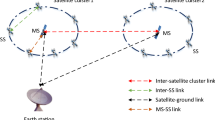Abstract
In mmWave communication system we propose a simplified Genetic Algorithm (GA) in multiple-beam combination, which helps to overcome problems such as grating-lobe in common beam-forming algorithms, and it can get a better Signal Noise Ratio (SNR) performance at User Equipment (UE). The simplified GA can select optimal antenna cells from massive antenna array with a lower computational complexity and higher power-efficiency. Theoretical analysis and software simulation show that the method can support more UEs with a higher power efficiency, reduce the bit error rate and computational complexity.











Similar content being viewed by others
References
Roh, W., Seol, J. Y., Park, J., et al. (2014). Millimeter-wave beamforming as an enabling technology for 5G cellular communications: Theoretical feasibility and prototype results. Communications Magazine IEEE, 52(2), 106–113.
Amani, N., Wymeersch, H., Johannsen, U., et al. (2020). Multi-Panel Sparse BS Design with Physical Antenna Effects in Massive MU-MIMO. IEEE Transactions on Vehicular Technology, 69(6), 6500–6510.
Hong, W., Yu, C., et al. (2020). Millimeter Wave Technology for 5G and Beyond. Journal of Microwave, 36(1), 12–16.
Souto, V. D. P., Souza, R. D., Uchôa-Filho, B. F., & Li, Y. (2020). A novel efficient initial access method for 5 g millimeter wave communications using genetic algorithm. IEEE Transactions on Vehicular Technology, 68(10), 2019.
Kutty, S., & Sen, D. (2016). Beamforming for millimeter wave communications: An inclusive survey. IEEE Communications Surveys & Tutorials, 18(2), 949–973.
Nandi, S., Nandi, D. (2017). Comparative study of rain attenuation effects for the design of 5G millimetre wave communication between tropical and temperate region. In 2017 Devices for integrated circuit (DevIC), pp 23–24 March, Kalyani India.
Rappaport, T. S., Gutierrez, F., Ben-Dor, E., et al. (2013). Broadband millimeter-wave propagation measurements and models using adaptive-beam antennas for outdoor urban cellular communications. IEEE Transactions on Antennas & Propagation, 61(4), 1850–1859.
Spencer, Q. H., Jeffs, B. D., Jensen, M. A., et al. (2006). Modeling the statistical time and angle of arrival characteristics of an indoor multipath channel. IEEE Journal on Selected Areas in Communications, 18(3), 347–360.
Zhang, J., Huang, Y., Shi, Q., et al. (2017). Codebook design for beam alignment in millimeter wave communication systems. IEEE Transactions on Communications, 99, 1–1.
Rappaport, T.S., Ben-Dor, E., Murdock, J.N., et al. (2012). 38 GHz and 60 GHz angle-dependent propagation for cellular & peer-to-peer wireless communications. In Communications (ICC), 2012 IEEE International Conference on. IEEE.
Perfecto, C., Ser, J.D., Ashraf, M.I., et al. (2016). Beamwidth optimization in millimeter wave small cell networks with relay nodes: a swarm intelligence approach.
Gao, X., Dai, L., Zhang, Y., et al. (2016). Fast channel tracking for terahertz beamspace massive MIMO systems. IEEE Transactions on Vehicular Technology, 66(7), 5689–5696.
Anand, A., Mukul, M.K. (2017). Comparative analysis of different direction of arrival estimation techniques. In IEEE international conference on recent trends in electronics, information & communication technology. IEEE, pp 343–347.
Aliyazicioglu, Z., Hwang, H. K., Grice, M., et al. (2008). Sensitivity analysis for direction of arrival estimation using a Root-MUSIC algorithm. Engineering Letters, 16(3), 353–360.
Rozé, A., Crussière, M., Hélard, M., et al. (2016). Comparison between a hybrid digital and analog beamforming system and a fully digital Massive MIMO system with adaptive beamsteering receivers in millimeter-Wave transmissions. In International symposium on wireless communication systems. IEEE, 86–91.
Yusuf, Y., & Gong, X. (2008). A low-cost patch antenna phased array with analog beam steering using mutual coupling and reactive loading. IEEE Antennas & Wireless Propagation Letters, 7(1), 81–84.
Zi-yang, B. A. O., Ke-song, C. H. E. N., Zi-shu, H. E., et al. (2009). Sparse circular arrays method based on modified DE algorithm. Journal of Systems Engineering and Electronics, 31(3), 497–499.
Krivosheev, Y.V., Shishlov, A.V. (2010). Grating lobe suppression in phased arrays composed of identical or similar subarrays. In IEEE international symposium on phased array systems & technology. IEEE
Amadori, P. V., & Masouros, C. (2015). Low RF-complexity millimeter-Wave beamspace-MIMO systems by beam selection. IEEE Transactions on Communications, 63(6), 2212–2223.
Xiong, J., Wang, W. Q., Shao, H. Z., et al. (2016). Frequency diverse array transmit beampattern optimization with genetic algorithm. IEEE Antennas and Wireless Propagation Letters, 16, 1–1.
Makki, B., Ide, A., Svensson, T., et al. (2016). A genetic algorithm-based antenna selection approach for large-but-finite MIMO networks. IEEE Transactions on Vehicular Technology, 99, 1–1.
Author information
Authors and Affiliations
Corresponding author
Additional information
Publisher's Note
Springer Nature remains neutral with regard to jurisdictional claims in published maps and institutional affiliations.
Rights and permissions
About this article
Cite this article
Bing, L. A simplified genetic algorithm in multi-beam combination for mmWave communication system. Telecommun Syst 78, 15–24 (2021). https://doi.org/10.1007/s11235-021-00788-9
Accepted:
Published:
Issue Date:
DOI: https://doi.org/10.1007/s11235-021-00788-9




